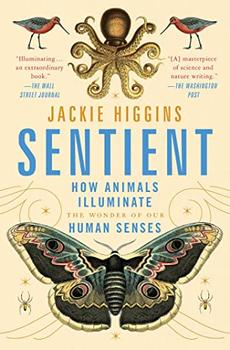Summary | Excerpt | Reviews | Beyond the Book | Readalikes | Genres & Themes | Author Bio

Critics' Opinion:
Readers' Opinion:
First Published:
Feb 2022, 320 pages
Paperback:
Nov 2022, 320 pages
 Book Reviewed by:
Book Reviewed by:
Elisabeth Herschbach
Buy This Book
Marshall's fascination with Tyson and his brotherhood began some thirty-five years ago, on the other side of the world. He was beginning a PhD with Mike Land at the University of Sussex in England and had been scouting around for a subject when the decision was made for him by the visit of a foreign dignitary. ''A larger-than-life African princess wearing a psychedelic caftan of many colors came to see the aquarium room," he recalled. ''As she walked through the door, all the stomatopods leaped to the front of their tanks and waved their appendages. I began to wonder if they might see color: a radical step for such a small-brained crustacean." Marshall decided to have a closer look. Under a light microscope, the surface of the peacock mantis shrimp's eye resolved into thousands of tightly packed hexagonal lenses called ommatidia, faceted like the compound eye of a fly. A line running horizontally across the middle caught Marshall's interest. "I could see a midband made up of six parallel lines of ommatidia, in which each ommatidium was bigger and more raised than those in the rest of the eye." To understand how these elements worked, he had to look closer still; he had to access their inner architecture.
With great care, Marshall froze, then finely sliced the midband and placed the sections beneath the microscope. What he saw through the eyepiece was extraordinary: "Each ommatidium was made up of light-sensing cells stacked one on top of another - three tiers in the first four rows, two tiers in the lower two." Yet their microstructure was not the most startling aspect: "I was expecting to see transparent things under the microscope, but lo and behold, I saw tiny blocks of bright, different colors instead." Reds, oranges, yellows, blues, pinks, and purples were scattered throughout the ommatidia - a rainbow hidden within the creature's eye. Similar colored oil droplets had been observed before in animals such as birds, where they filter light and enable color vision. "This was a pretty persuasive clue that these animals see color," Marshall told me. "I let out a litany of expletives and went to find Mike." Marshall would need a rare piece of scientific equipment. ''At the time there were only four of these machines in the world," he explained, "so Mike shipped me off to Baltimore for a few months, to Tom Cronin's lab. Tom had the kit and was the crustacean vision man." A micro spectrophotometer passes a narrow beam of light through a microscopic section of cells, and by measuring what reaches the other side, it identifies what light they absorb. It would allow Marshall to examine the sensory cells within the mantis shrimp eye that receive and respond to light: its photoreceptors. The work must be done in near darkness, targeting photoreceptors mere thousandths of a millimeter across. Analyzing the ommatidia row by row, Marshall started to notice that the various cells within the rows absorbed different light wavelengths. In the first four rows, he found as many as eight types of photoreceptors, each tuned to a distinct color wavelength. Here was proof that the colored oil droplets he had seen were indeed filters and that the mantis shrimp's world was full of color. "These eight photoreceptors meant the peacock mantis shrimp has color sight more complex than any animal ever studied at the time and more complex than I could have dreamed up," said Marshall. "The story Justin brought back from America was amazing," agreed Land. "Some birds and butterflies may have as many as five, but eight!" Marshall took stock: "If this was shocking, there was more to come"
Marshall's investigations would uncover four additional photoreceptors for wavelengths of light that are invisible to our eye. Ultraviolet vision may not be unusual in the animal kingdom - it was known already in birds, bees, and butterflies - but it expanded the mantis shrimp's sense of color and brought the count of photoreceptors to twelve. "It was such a ludicrous excess of color capability that I was baffled. It did not make sense," admitted Marshall. Meanwhile, Land realized that "this was a color system quite unlike ours, or any other known animal." Further research revealed further excesses: eight more photoreceptors, including six for a property of light called polarization that specifies how it vibrates. Whereas color-blind octopuses see patterns of polarized light, the mantis shrimp detects not only color and regular polarized light but also circularly polarized light, which vibrates differently again. This last talent enables stomatopods to extract yet more information from the sun's rays. To our knowledge, no other animal can see circularly polarized light, so they use it among themselves as a secret channel of communication.
Excerpted from Sentient by Jackie Higgins. Copyright © 2022 by Jackie Higgins. Excerpted by permission of Atria Books. All rights reserved. No part of this excerpt may be reproduced or reprinted without permission in writing from the publisher.




Judge a man by his questions rather than by his answers.
Click Here to find out who said this, as well as discovering other famous literary quotes!
Your guide toexceptional books
BookBrowse seeks out and recommends the best in contemporary fiction and nonfiction—books that not only engage and entertain but also deepen our understanding of ourselves and the world around us.